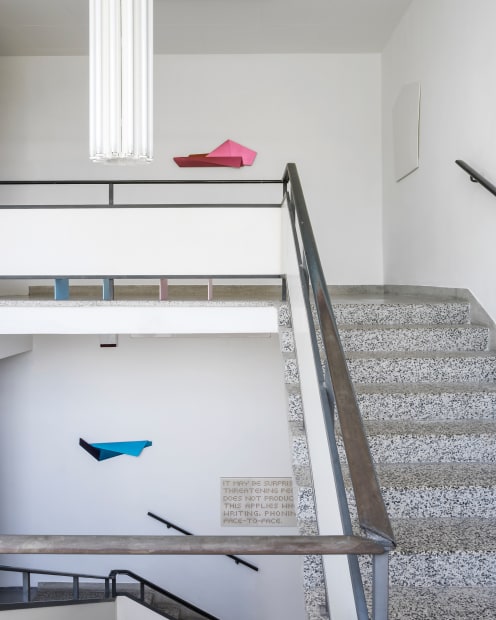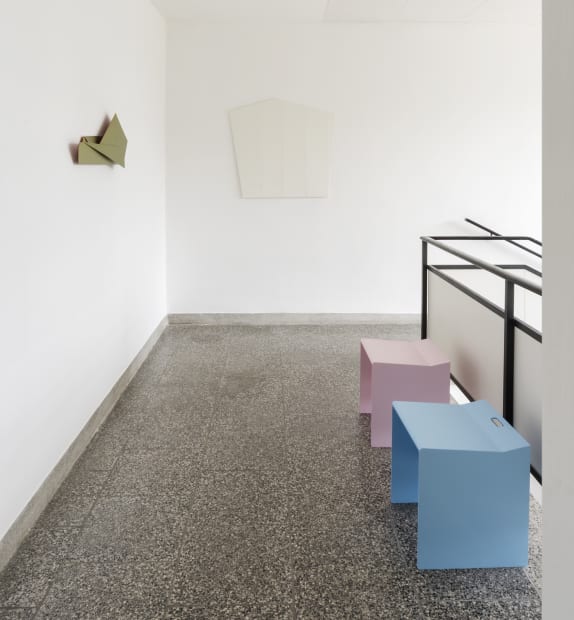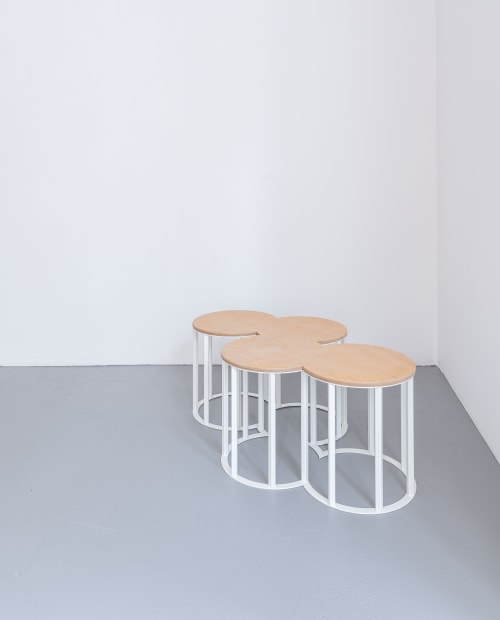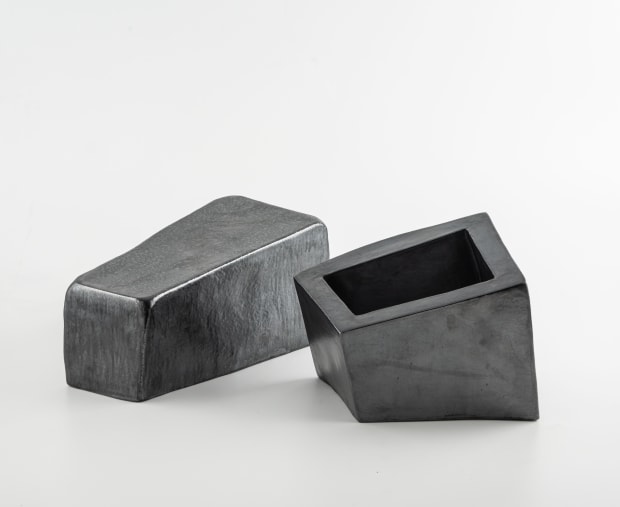
Sébastien de Ganay deliberately locates his works between artistic genres and thus creates works that elude a clear categorization in image, relief, object or furniture and blur the boundaries between the genres. As an innovative representative of experimental painting and sculpture, de Ganay combines abstract, figurative & functional elements to activate the senses and challenge conformist behaviors. Evident is the incredible diversity in de Ganay's oeuvre, whose works are nevertheless linked to one another through common structures, systems, and modes, and through which the artist questions the boundaries between genres, traditions, categories, and classifications.
This Viewing Room presents six different groups of works in which paradox plays a central role and shows how de Ganay unites seemingly contradictory things in his innovative and experimental work.

In the Museum Grids series made of reinforced steel, the artist transfers scaled architectural floor plans and blueprints of renowned museums into his own spatial and grid-like design language. While de Ganay used to refer to the formal structures of Minimal Art works from the 1960s and 70s in his earlier Grid series – as in the work on the right Grid Mangold (2017) –, the Museum Grids now also illustrate political structures. This reduction not only gives the buildings additional characteristica, but also allows the buildings themselves to appear as expressions of cultural and sometimes questionable power. By utilizing warning colors, the grids challenge the viewer to reflect upon what a museum represents: which artists are shown, how it has grown historically and where the artworks are actually from. Through architectural analysis, de Ganay illustrates to the viewer that the context of art is also determined by the surrounding space. Thus, that museums are not just places for the representation of individual works, but also reflect contemporary social and societal order.

In Museum Grids, De Ganay creates three-dimensional objects that stand out from the mere two-dimensionality of the image or the underlying floor plan through their materiality, scale and color. They unfold into independent line drawings within the space. Depending on the position and superposition of the reinforcement bars, the grids protrude from the walls and enable the viewer to have multiple perspectives of the structures. More prominent than significant characteristics of identifiable museums are the actual architectural plans and structures, reminiscent of circuits or control modules: these project an image closer to the cold and sterile digital space than to an analogue, in person experience.


Sébastien de Ganay, Grid Louvre, 2021

Pavilion Naked (2021) is a walk-in sculpture that encourages visitors to change perspectives within the exhibition. The hollow structure of steel tubes represents both a spatial drawing and an intervention in the space, creating new interplays between the works. De Ganay constructs a space within a space without actual volume. The shape of the pavilion is made up of individual open modules that form a reference system to previous groups of works. Incorporating existing structures serves the artist as a formal link between the series of works. In Pavillon Naked, the fictional space structure is revealed and encourages us to take a deeper look into our surrounding gallery space.
Photo: Simon Veres
Sébastien de Ganay, Pavillon Naked, 2021

The series of works Folded Flats is in continuity with Sébastien de Ganay's research since the early 90s into folding techniques. Inspired by everyday post-its, he examines the folding possibilities of the square in a variety of shapes and formats. In a serial working method, de Ganay produces abstract wall sculptures with minimalist gestures made of aluminum, which are based on a painterly approach with their pure colors and their play of light and shadow. The geometric forms refer to the reduced formal language of Minimal Art. De Ganay, however, extends their strict understanding of form and material ("What you see is what you see" - Frank Stella), as the Folded Flats do not reveal themselves at first glance, but invite the viewer to mentally participate, to get to the bottom of things further.
Photo: Simon Veres

Due to the high recognition value of Post-its, the works open up a space of imagination for the viewer that runs parallel to the artistic process and encourages them to think further about the variations or to meditate on the square form itself. Using folds, the artist creates spatial bodies with spontaneous geometries that reveal both the front and back with playful ease. The Folded Flats can be classified between the second and third dimension, between surface and space. While de Ganay moves between art and design in many of his works, with the Folded Flats he aims at the border area between genres within art: "When I hang a Folded Flat on the wall, it is both a picture and an object and definitely a bas-relief, almost even a sculpture."
Studio view Sébastien de Ganay | Photo: Simon Veres

Sébastien de Ganay, XL Folded Flat Yellow 01, 2018

With the Carton Library Stool series de Ganay enters the field of the applied object and breaks down the boundaries between art and design by developing sculptures that, through the way they are folded, become seats with an integrated compartment for books. Starting from an everyday cardboard box de Ganay creates a comprehensive corpus of works that explore the versatile potential of folding. Sébastien de Ganay understands the material and manifestations of cardboard boxes as a field of experimentation with great potential for transformation, which he has been exploring since 2002.
Studio view Sébastien de Ganay | Photo: Simon Veres
Sébastien de Ganay, Carton Library Stool Pink, 2016

On the basis of the flat cardboard, it can be transformed into the third dimension and from indeterminacy into the applied. In the style of Readymades and Arte Povera, de Ganay starts out from a simple utility material and combines this with an examination of the surface in the tradition of Minimal Art. The fast-moving cardboard is translated into high-quality aluminum with a granulated lacquer finish.
Works from the Carton series were exhibited in 2013 at the Centre Pompidou in Paris and at the St. Moritz Art Masters.
Studio view Sébastien de Ganay | Photo: Simon Veres

In the series of works, Seascapes, begun in 2011, de Ganay explores the surface as a free, variable form as well as a reference to the "Shaped Canvases" of Minimal Art. He places excerpts from sea view photographs by photography pioneer Gustave Le Gray from the early days of the genre, mid-19th century, onto copper plates. The different modes of appropriation are both visible and alienated by the new shape and the materiality of reflective copper. Early in his career, the artist broke away from using rectangular canvases; instead favoring circular forms and partially overlapping modules in various shapes and sizes.

In Seascapes, the circular shape is also inspired by de Ganay's travels to Japan, where the circle often appears in Zen gardens and monasteries as a symbol of knowledge. It also recurs in drawings, objects or as architectural elements such as windows, giving a view of the landscape and simultaneously referring to the viewer’s internal and external worlds. De Ganay deliberately places his work between artistic genres, whereby the Seascapes alternate between object, painting and photography, combining the past and the present. The reflective copper sepia hue picks up on the gloomy moods of seascapes in Normandy and Brittany, reminiscent of early photographs.
The viewer’s wandering eye, usually lost in the landscape, is reflected back by the reflective copper surface and brings a fragment of the present into Le Grey's early pictures.
Photo: Gustave Le Gray, La Grande Vague, Sète, 1857
Sébastien de Ganay, Seascape 9, 2021
!['I consider myself neither a painter nor a sculptor [...] I consider myself an experimenter who tries to find out...](https://artlogic-res.cloudinary.com/w_620,h_620,c_limit,f_auto,fl_lossy,q_auto/ws-maxgoelitz/usr/images/feature_panels/image/items/01/01b18ec2858d4dd2af6f9104a3e47b52/s-bastian-de-ganay_seascape-9_sdg94_dirk.tacke_f.jpg)
– Sébastien de Ganay

The series of modular OPSD Stools – similar to the Seascapes series – is made up of "Open System Disks” variations and follows the principle of freely arranged circular modules to form a specific shape. Sébastien de Ganay deliberately classifies OPSD STOOL 3 (2018) and OPDS STOOL 4 (2018) between artistic genres and thus creates works of art that defy clear categorization in sculpture, object, table or stool. The boundaries between the genres are abolished, while the possible function is only discernable through its title.
In contrast to the Folded Flats, the main focus is not on opening the shape by folding, but on the multiplication and superimposition of the circle, which is made of wood and a powder-coated steel frame. The number of circles indicate people who can sit on OPSD stools and illustrate the unifying characteristics of the work, which, depending on its placement in the room, enables collective moments.
Sébastien de Ganay, OPSD STOOL 3, 2018

In the CERAMICS work group, de Ganay plays with the juxtaposition and with what at first glance appears to be a paradoxical connection between foreignness and familiarity.
Studio view Sébastien de Ganay | Photo: Simon Veres



De Ganay classifies his CERAMICS as "familiar objects”, in contrast to the term "specific objects”, which was coined in 1965 by the artist and critic Donald Judd. “Specific objects” are specific because the artist carefully coordinates their shape, scale, proportions and materiality. In comparison, the CERAMICS are both puzzling and familiar, as if they were created by natural chance. The artist uses this ambivalent effect in the CERAMICS as well as in the "Seascapes”, as a game to emancipate things from their being and as a possibility to make them look like something other than what they really are. In CERAMIC 72, CERAMIC 90 and CERAMIC 104, De Ganay uses ceramics as a sculptural material that absorbs and preserves movement and impressions. The glaze of the sculptures is reminiscent of matt white Carrara marble and, as de Ganay says: "They are nothing less than the expression of potentials and metamorphoses in the making."
Sébastien de Ganay, CERAMIC 90, 2021

CERAMIC 68 (2020), CERAMIC 70 (2020) and CERAMIC 105 (2020) are works that defy clear categorization. Sébastien de Ganay consciously places his works between art and design, between sculpture and object, in order to question processes of perception and categorizations. As a representative of experimental painting and sculpture, de Ganay combines abstract, representational and functional elements into objects with a painterly aesthetic in this series of works. He forms two cylinders for each CERAMIC, between which he places a round plate as a connecting element, whereby the glaze of the lower cylinder differs in color from the upper two parts. The artist often experiments with basic geometric structures, which he combines with influences from the world of everyday objects. The ceramics are reminiscent of vases or lamp stands and create a feeling of abstract familiarity that playfully challenges the viewer to participate in the mental game.
Sébastien de Ganay, CERAMIC 105, 2020
biography
Photo: Lisi Specht
De Ganay studied political science and film at Columbia University in New York and is co-founder of the art book publishing house onestar press. In addition to numerous exhibition participations, including the Centre Pompidou in Paris and the Landesmuseum Österreich in St. Pölten, Austria, the Institut Français in Vienna showed a comprehensive solo exhibition of the artist in 2014. In 2017, de Ganay realized a highly acclaimed installation for the Kunsthalle Krems in a former Dominican church, which was accompanied by an overview catalog of his work.
→ further informations about the artist
Photo: Simon Veres





















